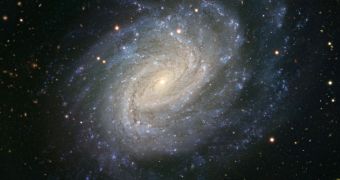Using one of the most capable observatories on the planet, a team of astronomers was recently able to snap the most impressive view to date of the spiral galaxy NGV 1187. The cosmic formation has been the home of two supernova blasts over the past 30 years.
In order to obtain an extremely detailed image, scientists turned to the Very Large Telescope (VLT), which is located at the La Silla Observatory, in Chile. The entire installation was built, and is operated, by the European Southern Observatory (ESO).
NGC 1187 is not that far away, in astronomical terms. Existing data suggest it lies no more than 60 million light-years away, in the constellation of Eridanus (The River). The structure has almost a face-on orientation, which enables astronomers to survey its inner structure.
Its massive spiral arms are also clearly visible, as are numerous dust lanes permeating its interior. The numerous blue spots are areas occupied by young stars, which shine with a bluish tint. Scientists believe that the galaxy still has very active stellar nurseries.
These are accumulations of vast amounts of molecular hydrogen gas, which tends to clump up around gravitational centers. Eventually, clouds separate, which continuously accrete mass until a certain threshold is exceeded. Once this happens, they collapse under their own weight.
In the process, extreme friction heats the gas to millions of degrees. If the original cloud is large enough, a new protostar will form. The object will first be shrouded in dust, but it will eventually consume the material and emerge as a fully-fledged star.
Old galaxies such as our own produce only limited amounts of stars yearly. This reduced production rate is not owed to limited amounts of hydrogen gas, but rather to the fact that nothing swirls the gas, forcing it to come together.
When the Milky Way collides with Andromeda, the two galaxies will put their gases in common, and mix them violently. A new wave of stars will be the result, making the ensuing elliptical galaxy appear younger than it is.
NGC 1187 is still some distance away from such a scenario. It looks to be relatively young, too, experts say. Unlike other spiral galaxies, which feature a round bulge, this formation boasts a subtle central bar structure. The latter is not large enough to classify the galaxy as a barred spiral.
The reason why NGC 1187 hosted two supernova blasts in just three decades could be that it has many massive stars, which tend to live short lives compared to yellow dwarfs such as the Sun.

 14 DAY TRIAL //
14 DAY TRIAL //